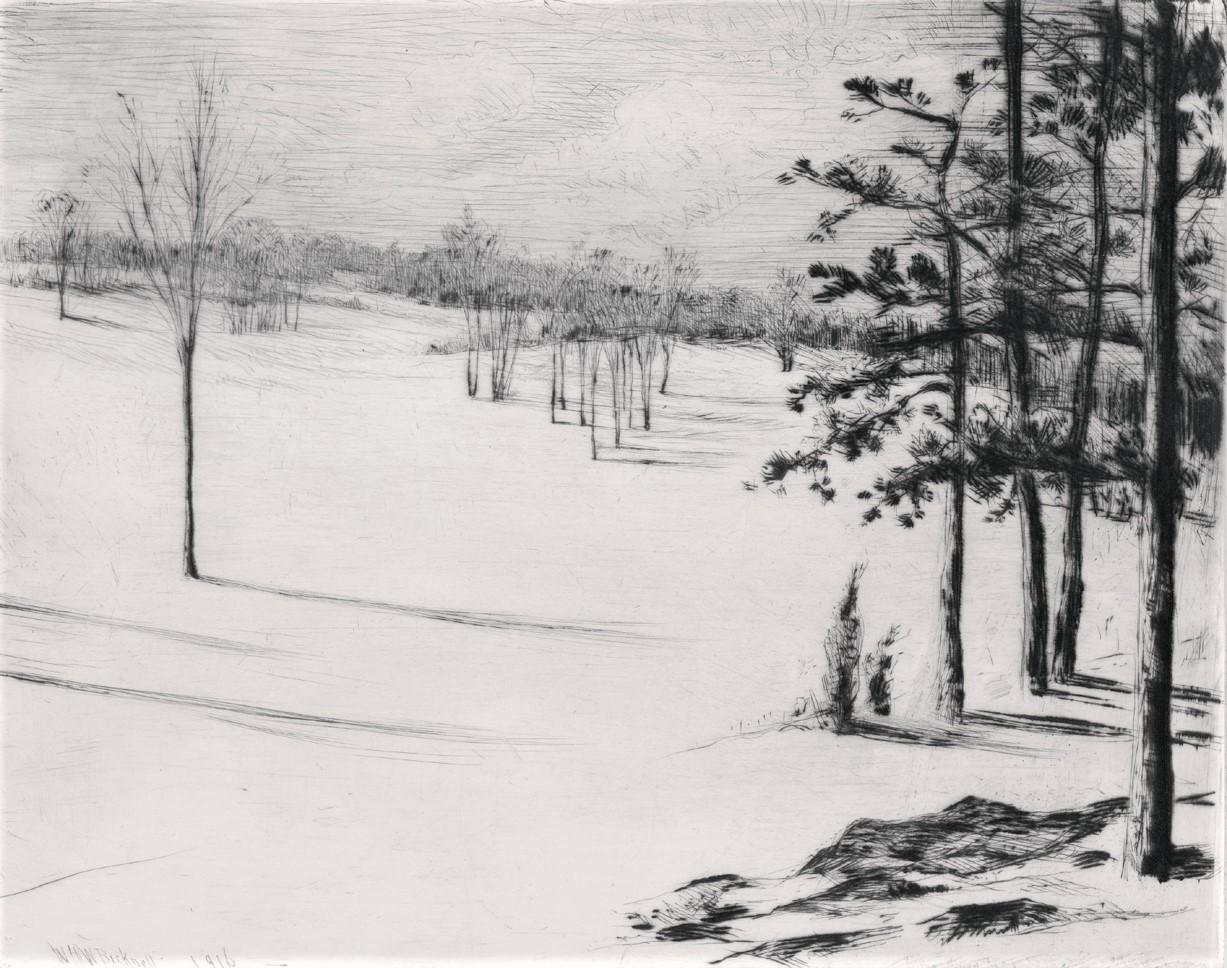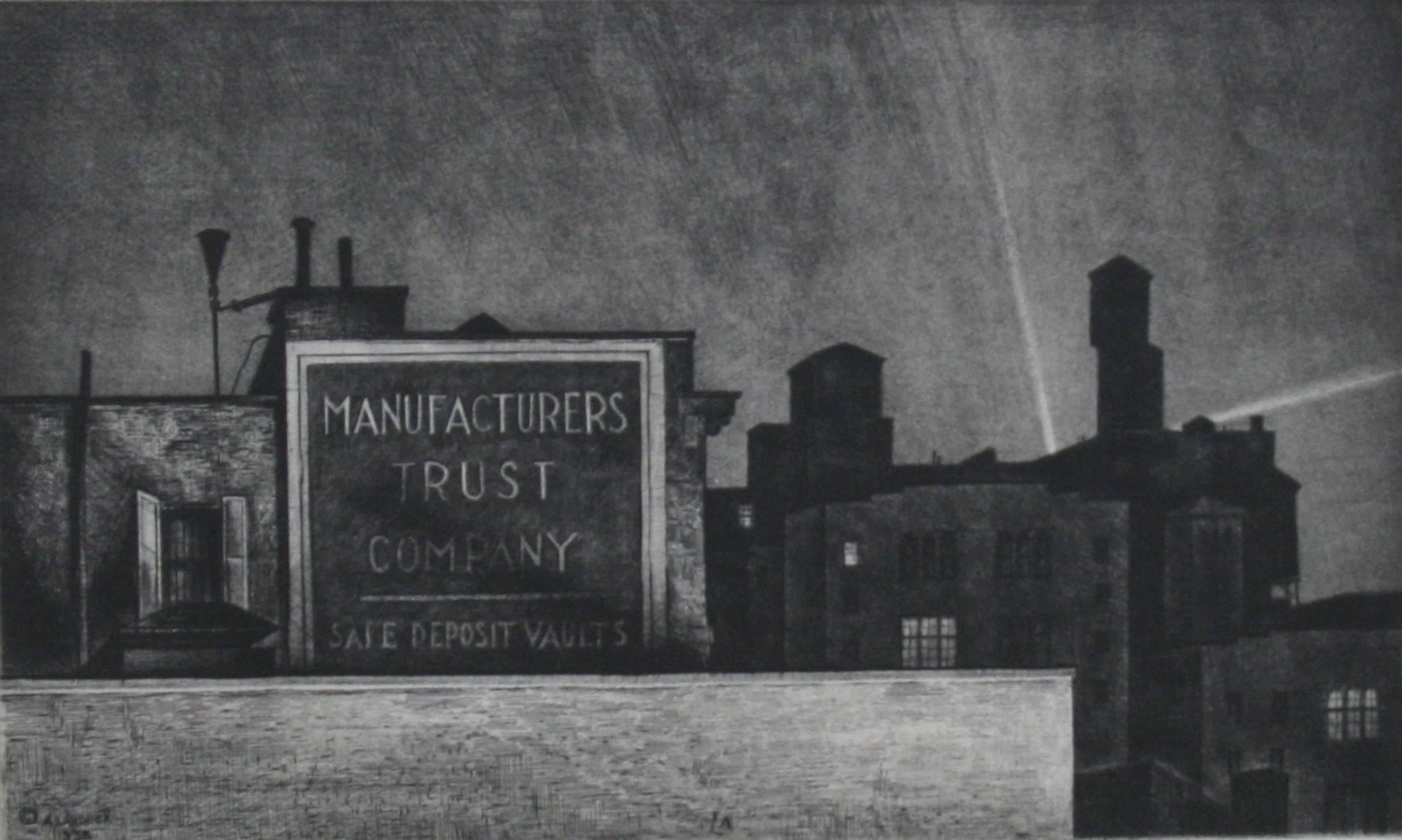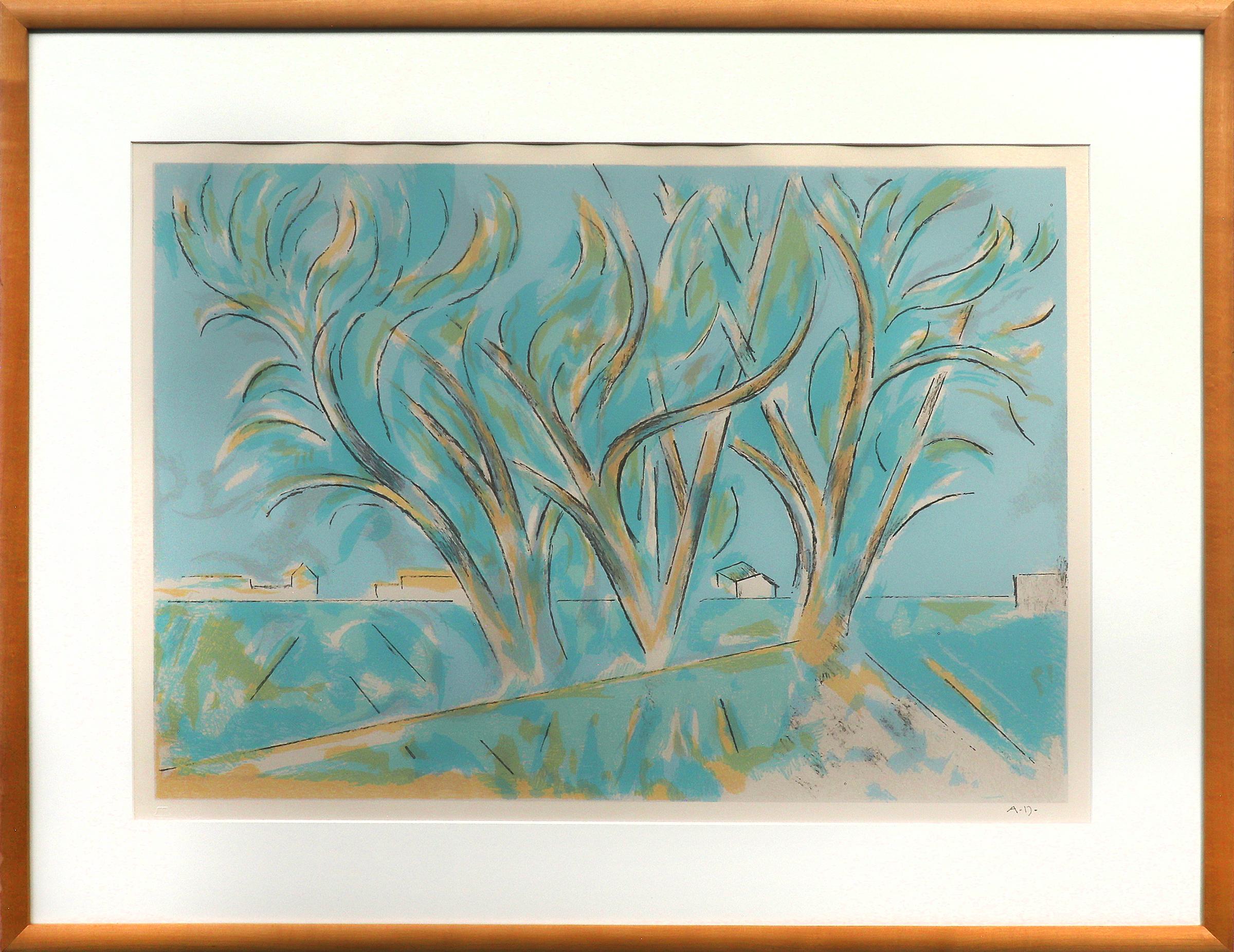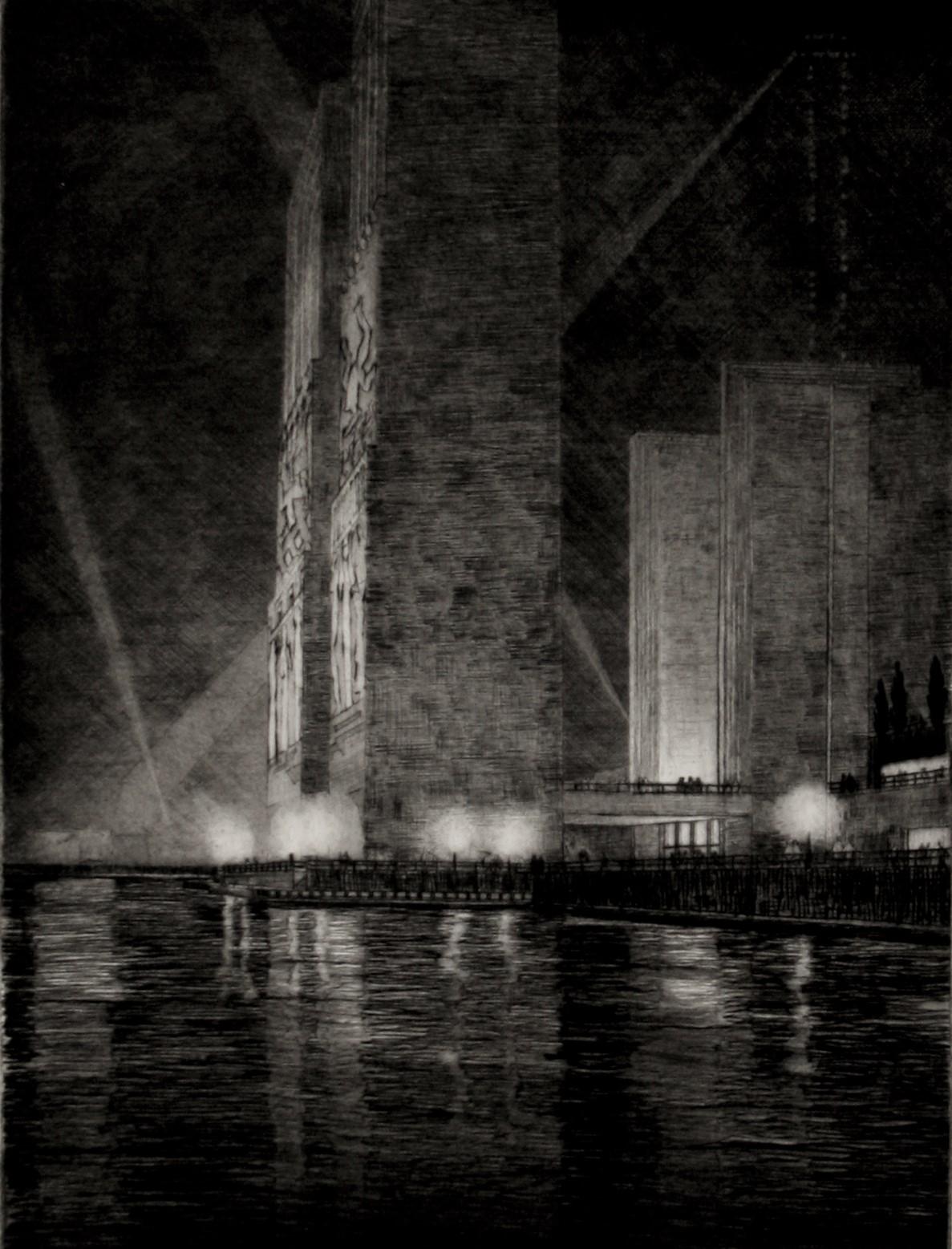Items Similar to Mornings with Judd (Second state)
Want more images or videos?
Request additional images or videos from the seller
1 of 9
Peter MiltonMornings with Judd (Second state)1970
1970
About the Item
Lift ground and hard ground etching and engraving on Murillo white wove paper, 18 x 24 inches (455 x 608 mm), full margins. Signed, dated, titled and numbered 60/100 in pencil, lower margin. Printed and published by the artist. In very good condition with minor age tone and scattered light surface soiling on the verso. Framed handsomely in an original Kulicke welded aluminum frame with the embossed maker's mark. [Milton 61].
Milton revisited this image in 1974 during an experiment to explore collage and the process of contact printing a high resolution photo-transparency directly onto a copper plate. He printed a small detail transparency of Mornings with Judd onto the existing plate, alongside it's larger self, and broke through to a new photo-resist approach, which Milton described as "piquant and irresistible," in his essays appearing in Robert Flynn Johnson's catalog raisonné of his complete prints. After the application of this new technique to the plate, Morning's With Judd (Second State) evolved, and was aptly renamed "The First Gate."
About the frame maker:
Robert Moore Kulicke was born in 1924 in Philadelphia, where he studied advertising and design at the Philadelphia College of Art. Upon his return from Europe after serving three years in World War II, Kulicke became very focused on the art of picture framing. An accomplished painter himself, Kulicke eventually settled in New York, where he befriended the Abstract Expressionists Franz Kline and Robert Motherwell. Their work inspired him to design frames based on a simple construct of polished aluminum, which would eventually be used on hundreds of works by Kline and Motherwell, as well as other notable Modernists. The tasteful and simple aluminum "Kulicke frame" was commissioned by the Museum of Modern Art in 1956 for use in traveling exhibitions, and Kulicke subsequently also designed a Lucite frame for the Museum's photography collection. A "floating" frame he created in the 1950s was utilized by MoMA on some of its most well loved masterpieces after the Museum's expansion in 1984. Kulicke, who died in 2007, is considered to have single-handedly revolutionized the way we see postwar art through his modernization of how it is viewed.
- Creator:Peter Milton (1930, American)
- Creation Year:1970
- Dimensions:Height: 18 in (45.72 cm)Width: 24 in (60.96 cm)
- Medium:
- Movement & Style:
- Period:
- Condition:
- Gallery Location:Middletown, NY
- Reference Number:
About the Seller
5.0
Vetted Seller
These experienced sellers undergo a comprehensive evaluation by our team of in-house experts.
Established in 2004
1stDibs seller since 2022
28 sales on 1stDibs
Typical response time: 12 hours
- ShippingRetrieving quote...Ships From: Middletown, NY
- Return PolicyA return for this item may be initiated within 30 days of delivery.
More From This SellerView All
- Les Belles et La Bête I: The RehearsalBy Peter MiltonLocated in Middletown, NYResist ground etching and engraving on Rives heavyweight buff paper, 20 x 36 inches (508 x 914 mm), full margins. Signed, titled, dated and numbered 103/160 in pencil, lower margin. Minor mat tone. A rich and finely printed impression of this complex and iconic work by Milton. Framed handsomely under Plexiglas with archival materials in a solid wood frame with silver finish. [Milton 98]. Milton states that in the evolution of his body of graphic work he found himself at point that necessitated the exertion of nerve in his subject matter. He found it imperative for growth to explore whether his compositions had previously been too polite, and through this process he experienced a great burst of artistic and psychic liberation. Milton refers to this awakening as a sort of adolescence, which he felt demanded a natural examination of mysteries of sexual awakening. Les Belles et La Bête...Category
1970s American Modern Interior Prints
MaterialsArchival Paper, Engraving, Etching
- Les Belles et la Bête: Before the HuntBy Peter MiltonLocated in Middletown, NYResist ground etching and engraving on cream wove paper, 22 x 39 inches (558 x 990 mm), full margins. Signed, titled, dated, and numbered 27/160 in pencil, lower margin. With the blindstamp of the printer, Robert E. Townsend, in the lower left margin. A beautiful, richly inked impression of this highly detailed, large image. In very good condition with minor mat tone, extremely minor scattered light surface soiling, and one pin-point sized dot of brown discoloration on the lower left margin, recto, well outside of image area. [Milton 99]. Milton states that there is a metaphorical evolution at the root of his body of graphic work, and with Les Belles et la Bête, Before the Hunt, he found himself at a crossroads that he viewed as a sort of artistic adolescence, which he felt demanded a natural examination of mysteries of sexual awakening. The image is brimming with fantastical images and metaphors for the confrontation of sexual exploration; a Freudian analyst appears in the left of the image, scattered tableaus of paired figures...Category
1970s American Modern Interior Prints
MaterialsArchival Paper, Engraving, Etching
- Low Country (South Carolina)By Elizabeth VernerLocated in Middletown, NYAn enchanting Southern landscape by the mother of the Charleston Renaissance. A native of Charleston, South Carolina, and educated under the tutelage of Thomas Anshutz at The Pennsylvania Academy of Fine Arts, O'Neill Verner was a teacher, a mother, an artist, an ardent preservationist, and a skilled autodidact. Having previously focused on painting, in the early 1920s she found herself deeply moved by printmaking as a media, and especially so by the simple, peaceful themes and tableaus she discovered in Japanese art. She embarked on a effort to teach herself Japanese printmaking techniques, and in the process, produced the charming images of every day life in Charleston and its environs that earned her recognition as a cultural icon in her day, and in more modern times, as the mother of the Charleston Renaissance, which flourished well into the 1930s. In 1923 she opened a studio in Charleston where she focused on documenting the local color and the architecture and landscape that distinguishes Charleston as one of the South's most beautiful cities, all the while applying the gentle and poetic thematic sensibilities of Japanese printmaking. O'Neill Verner soon found herself in high demand when municipalities and institutions throughout the country sought commissions from her to document the beauty of their grounds and historic buildings. She worked as far north as the campuses of Harvard and Princeton, and extensively across the South, including in Savannah, Georgia, where through sweeping commissions she was able to marry her love of southern preservation and art. O'Neill Verner was a lifelong learner, and continued a path of edification that led her to study etching at the Central School of Art in London, to travel extensively through Europe, and to visit Japan in 1937, where she studied sumi (brush and ink) painting. She was a founding member of the Charleston Etchers Club, and the Southern States Art League. Her works are represented in the permanent collections of leading museums across the American south, and in major national institutions including the Metropolitan Museum of Art, Boston's Museum of Fine Art, and the Smithsonian American Art Museum. O'Neil Verner...Category
Early 20th Century American Modern Landscape Prints
MaterialsArchival Paper, Drypoint, Etching
- The Old Smyth Gate, Charleston, South CarolinaBy Alfred HuttyLocated in Middletown, NYA view of the gateway to Simmons-Edwards House (14 Legare Street), also known as the Pineapple Gate House. Etching with drypoint on watermarked "Hand Made" laid paper, signed in pen...Category
Early 20th Century American Modern Landscape Prints
MaterialsLaid Paper, Drypoint, Etching, Handmade Paper
- Tugs on the HudsonBy Charles Frederick William MielatzLocated in Middletown, NYDrypoint etching with engraving printed in black ink on Japanese mulberry paper, 4 1/2 x 3 3/8 inches (113 x 84 mm), full margins. In superb condition. A beautiful New York City rive...Category
Early 20th Century American Modern Landscape Prints
MaterialsHandmade Paper, Drypoint, Etching
- Rainy Day, ProvidenceLocated in Middletown, NYEtching with drypoint on Japan paper, 9 3/4 x 12 3/4 inches (245 x 322 mm), full margins, from an edition of approximately 50. Signed by the artist in pencil, lower center margin, t...Category
Early 20th Century American Modern Landscape Prints
MaterialsHandmade Paper, Drypoint, Etching
You May Also Like
- Edge of the Woods.By William Harry Warren BicknellLocated in Storrs, CTEdge of the Woods. 1916. Drypoint. 7 7/8 x 9 3/4 (sheet 10 7/16 x 13 1/8). A rich impression in printed on Japanese paper with an oak leaf watermark. Signed and annotated '3rd state'...Category
Early 20th Century American Modern Landscape Prints
MaterialsDrypoint, Etching
- Manhattan NocturneBy Armin LandeckLocated in Storrs, CTManhattan Nocturne. 1938. Etching and drypoint. Kraeft 70. 7 1/8 x 11 7/8 (sheet 10 1/2 x 15 1/4). Edition 100. Presentation Print of the Society of American Etchers, 1938. Provenanc...Category
1930s American Modern Landscape Prints
MaterialsDrypoint, Etching
- Demolition No. 1By Armin LandeckLocated in Storrs, CTDemolition No. 1. 1940. Drypoint. Kraeft 80. 4 7/8 x 8 7/8(sheet 12 x 13 7/8). Edition 100. Provenance: estate of David Llewellyn Reese, New York. A rich impression with tonal wiping...Category
1930s American Modern Landscape Prints
MaterialsDrypoint, Etching
- Skyline, New YorkBy Martin LewisLocated in Storrs, CTSkyline, New York. 1919. Etching and drypoint. McCarron 36. 8 7/8 x 10 3/8 (sheet 12 1/4 x 14 . 11 recorded impressions (intended edition 50. Lewis states that he destroyed 6 of the ...Category
1920s American Modern Abstract Prints
MaterialsDrypoint, Etching
- Trees in Ranchitos II, New Mexico, 1970s Color Lithograph Landscape with TreesBy Andrew Michael DasburgLocated in Denver, CO"Tree in Ranchitos II" (New Mexico) is a lithograph initialed lower right by artist Andrew Michael Dasburg (1887-1979) from 1975. Presented in a custom frame measuring 30 ½ x 36 ¼ inches. Image size is 16 ½ x 23 ¼ inches. About the Artist: Born France, 1887 Died New Mexico, 1979 Andrew Dasburg was born in Paris, but emigrated to New York City in 1892 with his mother. A childhood sickness left him lame, and his artistic propensities were first recognized by a teacher at the crippled children’s school. She enrolled him in the Art Students League in 1902. There he studied under Kenyon Cox, Frank Vincent Dumond, and Birge Harrison. Later, he began taking night classes from Robert Henri at the New York School of Art. Dasburg spent 1908-1910 in Paris, where he was introduced to the great impressionist painters Matisse and Cezanne. Inspired by the work of the European modernists, Dasburg returned to the United States, where he moved to Woodstock, New York. In Woodstock, he and his wife, Grace Mott Johnson, lived with Morgan Russell...Category
1970s American Modern Landscape Prints
MaterialsLithograph, Archival Paper
- Grand Canal, America (Electrical Buildings at Night)By Gerald GeerlingsLocated in Storrs, CTCzestochowski 31. 11 3/4 x 8 7/8 (sheet 12 x 18). Edition 100. Presentation print for the Chicago Society of'Chicago Fair 1933. A rich impression with t...Category
Mid-20th Century American Modern Landscape Prints
MaterialsAcrylic, Drypoint
Recently Viewed
View AllMore Ways To Browse
Vintage State
Vintage State Plates
Engravings Photo
1970 Advertising
Lucite Framed Art
Art In Lucite Frames
Vintage Travel Collage
Large Vintage Frames Photo And Picture Frames
Robert Motherwell Original
Franz Kline Prints
Retro Picture Collage
Copper Photo Frame
Vintage Collage Picture Frames
Framed Lucite Paper Art
Peter Moore
Embossed Copper Plate
Robert Motherwell Etching
Kulicke Frames





